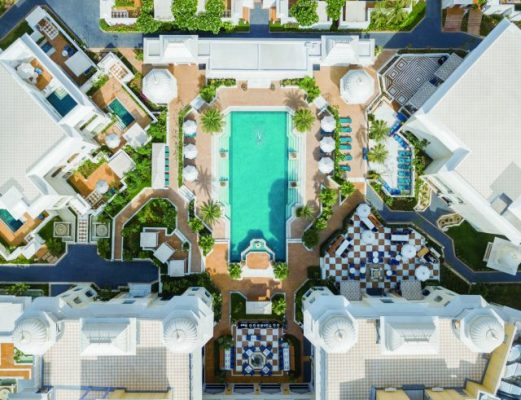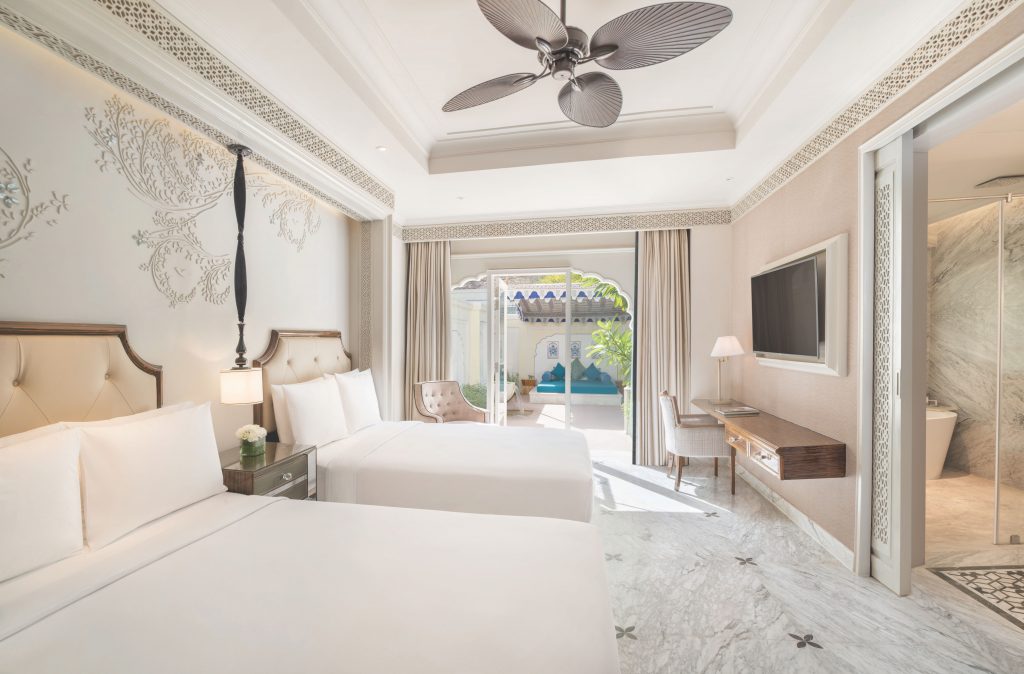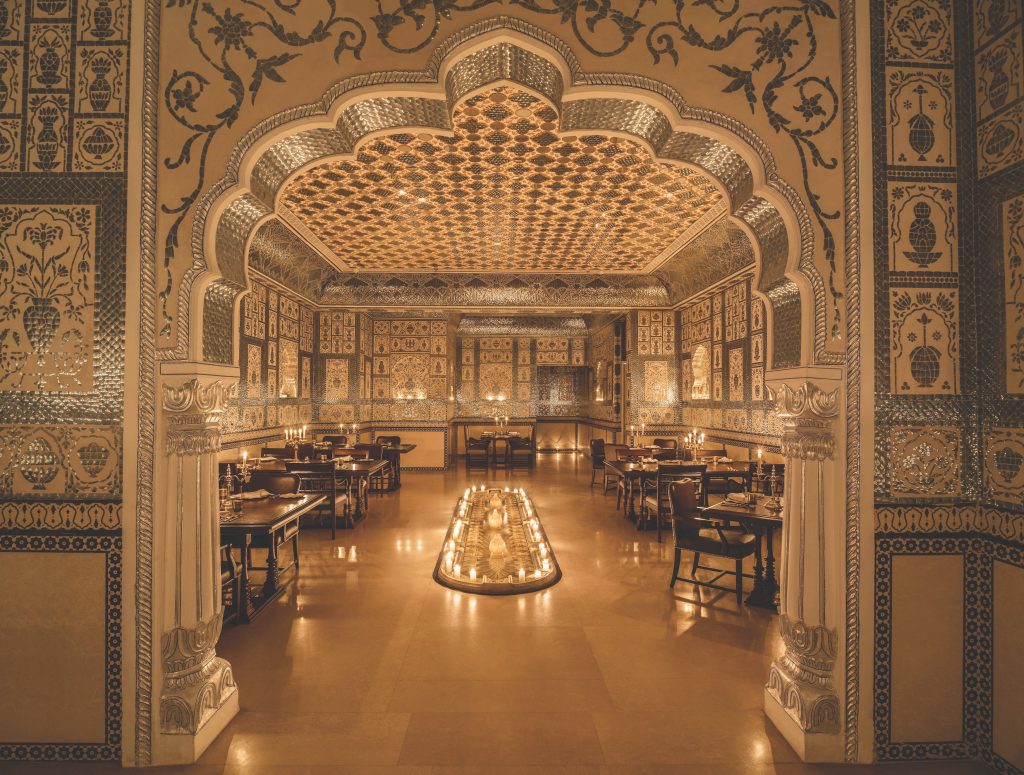On a journey through Jaipur, Masala discovers an oasis of royal treasures.
By Raghav Sachdev
Growing up in Thailand and staying at some of our nation’s finest hotels and resorts made me firmly believe that Thai hospitality was far superior to any other destination in the world. This was, however, until I had the opportunity to visit luxury palace hotels in Jaipur. With their proficient and welcoming staff, I was completely blown away during my time there. What’s better is that visiting the capital of Rajasthan has never been so convenient and affordable, as Thai Smile and AirAsia now offer direct flights from Bangkok to Jaipur.
We were returning to Jaipur after two years, and though it was summer, the city’s fabled pink walls, royal havelis and iconic architectural gems were once again a wonderful treat. After attending the International Convention of the Wedding Fraternity (ICWF) for three eventful days, it was time to unwind, and we opted for the city’s newest luxury property, the opulent JW Marriott Jaipur Resort & Spa.
Set amidst the Aravalli Range in Kukas, the immaculate resort pays homage to royal Rajasthani heritage by featuring grand arches and cascading fountains, with décor that highlights intricate ‘Jaali’ metalwork, abstract inlays and hand-painted patterns in a classic blue and white palette. While the exterior may exude a grand palace setting, the interiors are sleek and contemporary with a local touch to give visitors a true feel of olden-day royalty.
The expansive resort boasts 200 villas and suites with eight room options, including sleek pool villas. We stayed at the 105sqm Courtyard King Villa with an outdoor daybed and fountain. The villas were also beautifully minimalist with a comfortable bed and plush amenities – just what you’d expect from a Marriott property.
After settling in, we made our way to Sukh Mahal, the resort’s all day dining outlet, where we had an option to either indulge in a buffet or an expansive à la carte menu. Going with the latter, we tasted a delicious variety of Indian and International cuisine, where we especially savoured their Chinese-Indian fare. After a quick meal, we set off to do some exploring.
In Jaipur, you’ll come across a fair bit of international tourists, as the Pink City lures in visitors with its stunning remnants of a bygone era. The most popular attractions are dramatic forts, ancient palaces and colourful markets, known for their traditional handloom garments and antique ornaments.
By the time we returned to the resort, it was nightfall. We grabbed a late dinner at Sukh Mahal and strolled back to our villas, eagerly looking forward to what awaited us the following day.
We woke up to a lavish spread of Indian staples, mezzes, pancakes and waffles at the breakfast buffet. I decided to embrace my desi side by opting for a crispy egg paratha, which had me ready to kick-start my final day in Jaipur.
Though there were still a handful of forts to discover, I decided to enjoy the comforts of the property. The Marketing and Communications Manager, Sonali Khadka was generous enough to take me on a tour around the resort, where I got to see different types of rooms, versatile event spaces and the rooftop terrace, which is set to launch a Mediterranean restaurant very soon.
I was also privileged to meet the charismatic General Manager, Chandrashekhar Joshi, fondly known as CJ. After having successfully opened JW Marriott Mussoorie Walnut Grove Resort & Spa, CJ has settled into his role in Jaipur seamlessly. He revealed that since its inaugural, the resort has hosted more than 55 extravagant Indian weddings in less than eight months, an incredible feat, though he doesn’t prefer to label the property as merely an ‘Indian wedding hotel’. However, with its immaculate guestrooms, striking architecture and enticing location, it is no surprise that couples choose to tie the knot here.
After a quick dip in the pool, I decided to visit JW’s Health Club & Spa for a signature massage treatment. Afterwards, I made my way to Kukas ki Chaupar, an outdoor and informal setting, perfect for guests to sip on chai and nibble on snacks, while enjoying the picturesque surroundings and echoes of peacocks nearby. This high tea is complimentary for all in-house guests, and also features a live acoustic singer and a few team games to encourage networking amongst guests.
For dinner, everyone must visit the enchanting Mohan Mahal. This dazzling restaurant took three years to build, almost the same amount of time as the entire resort. Architecturally inspired by the iconic Sheesh Mahal in Jaipur, this riveting restaurant has more than 300,000 mirror installations. There are no lights, rather the dining room is lit by 101 candles and features a calming water body in the centre.
Needless to say, dining at Mohan Mahal is an imperial journey, as the cuisine honours the rich traditions and culture of Rajasthan. Priced at Rs.3,500++ (just under B2,000 per person), guests can either enjoy the vegetarian or non-vegetarian royal thali, served as appetisers, mains and desserts. We ended our meal with a warm cup of chai; a soothing finish to an impressive dining experience.
Before we knew it, our stay at Jaipur was over, and I left this majestic city with beautiful memories that I couldn’t wait to revisit.
Five must visit sites for every traveller:
1. Amer Fort:
Dating back to the 16th century, Amer Fort or Amber Fort undeniably offers the most spectacular setting in Jaipur. Once home to Rajput rulers, the fort, overlooking Maota Lake, was built to protect their queens. Once inside, you’ll witness elaborate mirror work which adds to the remarkable grandeur. If you were wowed by the magical setting of the film Bajirao Mastani (2015), than being inside will truly bring life to the palace’s story.
For those keen to experience Amer Fort in true maharaja style, opt for an elephant ride there; although I probably wouldn’t recommend this journey during the summer months. More importantly, be sure to get a trained guide!
2. Jal Mahal:
After enjoying a few hours at Amer Fort, be sure to ask your driver to make a quick visit to Jal Mahal, also known as the Water Palace. This ancient fort sits in the middle of Man Sagar Lake and makes for a beautiful postcard picture. Unfortunately, exploring the palace grounds are prohibited, but it is definitely worth a drive by.
3. Hawa Mahal:
Jaipur’s most distinctive landmark is an intricate façade constructed of pink and red sandstones spanning five floors and containing rows of small windows (jharokhas) and screens. Hawa Mahal neighbours the City Palace, where Jaipur’s Royal Family currently resides, and overlooks the main street of Jaipur’s lively Old City. The palace was built to allow women of the royal household to observe everyday life and festivals without being seen.
4. Bapu Bazaar:
For those not too keen on historical sites, Jaipur has your fair share of shopping too. Located near Hawa Mahal, Bapu Bazaar is the ideal place to buy trinkets and small souvenirs. The market also has numerous sari and fabric stores, though it’s a tad touristy. Be sure to negotiate to bag a good bargain!
5. Hathi Gaon:
JW Marriott Jaipur Resort & Spa features a range of enriching activities onsite, and can even organise visits to nearby villages, craft boutiques and a special excursion to Hathi Gaon, an elephant picnic. Here you can spend time bathing, feeding, riding and even painting the gentle giants.
JW Marriott Jaipur Resort & Spa
Jaipur-Delhi Highway, NH11, Kukas,
Jaipur, Rajasthan 302028, India
Tel: +91 142 666 6000
www.marriott.com/hotels/travel/jainh-jw-marriott-jaipur-resort-and-spa









